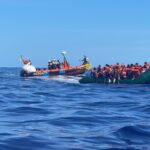A Turkish military cargo plane crashed near the Azerbaijan-Georgia border on Tuesday, November 11, killing all 20 military personnel on board in what has become Turkey’s deadliest military incident since 2020. The C-130 Hercules aircraft broke apart in mid-air before plummeting to the ground in Georgia’s Kakheti district, approximately five kilometers from the Azerbaijan border.
The aircraft, using call-sign TUAF543, departed from Ganja, Azerbaijan at 10:19 UTC and was heading to Merzifon in northern Turkey when disaster struck. According to flight tracking data, the plane reached its cruising altitude of 24,000 feet at 10:41 UTC. The last radar contact occurred at 10:49:20 UTC, with data suggesting a rapid descent during the final documented seconds of flight. The recorded vertical speed indications exceeded 19,000 feet per minute, pointing to a catastrophic failure.
Georgia’s air traffic control service reported that the aircraft disappeared from radar without issuing any distress signal before the crash. Video footage from the scene appeared to show the plane breaking into three distinct pieces while still airborne, with the cockpit section and tail separated from the main fuselage. The wreckage was scattered across multiple locations in the Sighnaghi municipality, an area that includes farmland surrounded by hills.
Turkish President Recep Tayyip Erdogan confirmed that 19 bodies had been recovered from the crash site, with search teams later locating the remaining victim. “Ongoing work at the crash site is being closely monitored, and all necessary investigations will be done meticulously to clarify every aspect of the incident,” Erdogan said at a meeting of provincial heads of his governing Justice and Development Party in Ankara. The black box flight recorder was also recovered and sent to Ankara for analysis.
Defence Minister Yasar Guler confirmed the deaths in a social media post that included photographs of the soldiers in their uniforms. “Our heroic comrades-in-arms were martyred,” Guler stated. A Turkish accident investigation team began inspecting the wreckage at the crash site in coordination with Georgian authorities.
The aircraft was carrying a 10-person maintenance team for Turkish F-16 fighter jets, along with flight crew and maintenance equipment. The team had attended Victory Day celebrations in Azerbaijan, marking the country’s battlefield success over Armenia in the conflict over the Nagorno-Karabakh region in 2020. Turkey and Azerbaijan maintain close military cooperation, with Ankara training Azerbaijani officers and supplying weapons to Baku.
The C-130 Hercules involved in the crash was a 57-year-old military transport aircraft manufactured in 1968. The plane initially served the Royal Saudi Air Force before Turkey acquired it from Saudi Arabia, with reports indicating it entered Turkish service around 2012. According to the defence ministry, the aircraft started flights in 2022 after undergoing modernization and had been regularly used and serviced since then. Its last maintenance was conducted one month before the crash.
The C-130 Hercules is a four-engine turboprop military transport aircraft capable of operating from unprepared runways. These planes are widely used by air forces around the world for transporting personnel, cargo, and other equipment. The aircraft was based in Kayseri, Turkey, and had flown regularly in recent months. Its last recorded flight before the fatal journey was between Kayseri and Ganja, arriving at 08:04 UTC on the day of the crash.
In response to the incident, Turkey grounded all flights by its fleet of 18 C-130 planes, suspending operations pending inspections. The decision came just weeks after the defence ministry announced a deal with Britain to procure 12 C-130J aircraft requiring modernization work.
International condolences poured in following the crash. NATO Secretary-General Mark Rutte conveyed his deepest condolences to Turkey and the families of those lost. “We honour their service and are deeply grateful for all that the Turkish Armed Forces, and indeed all our men and women in uniform across the Alliance, do to keep us safe every day,” he stated. Leaders and governments from countries including Azerbaijan, Georgia, Kazakhstan, Qatar, Egypt, Iran, Italy, and Malta also expressed sympathy.
US Ambassador to Turkey Tom Barrack expressed the country’s solidarity with Turkey, while Lockheed Martin, the manufacturer of the C-130 Hercules, offered its condolences and committed to assisting the investigation. Azerbaijani President Ilham Aliyev sent a message to Erdogan saying he was “deeply saddened by the tragic news of the loss of servicemen.”
The cause of the crash remains under investigation. Aviation experts noted the unusual nature of the aircraft breaking into three separate pieces while airborne, suggesting a catastrophic structural failure occurred. The recovery and analysis of the black box will be crucial in determining what led to the mid-air breakup of the decades-old transport plane.
A dignified military service took place at Ankara’s Murted Air Base, with the soldiers’ relatives, prominent political leaders, and senior Turkish Armed Forces officers in attendance. After the service, the remains were scheduled to be returned to their hometowns for burial.
The 20 coffins arrived in Turkey late Thursday. Once they landed in Ankara, they were placed in funeral vehicles and escorted in a convoy to the Ankara Forensic Medicine Institute. Television broadcasts showed large crowds gathered outside the institute, waving Turkish flags as they awaited the arrival of the procession.











